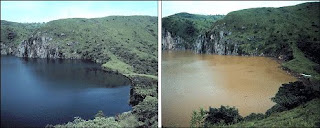Thursday, April 28, 2011
Killer Gas
The fast, thick cloud of CO2 killed quickly and silently. It displaced all the ordinary air and remained in the village for hours. People first became drowsy and disoriented, then passed out and finally died as their brains were starved for oxygen. Animals were also killed, from large animals like cattle to small animals like insects. Unlike other disasters that scour the landscape and wreck infrastuctures, the only damage Lake Nyos suffered was a swath of vegetation right near the north side, where the forceful expulsion created an 80-foot wave. The rest of the plants lived, creating the eerie and upsetting sight of roads, fields, and houses still standing, but everyone in the villages dead.
http://www.youtube.com/watch?v=YEPNYRD09es
Lake Nyos Disaster
The Lake Nyos disaster occurred on August 21st, 1986, at 9:30 PM. This particular lake is more than deep enough to hold a great amount of CO2 – a crater lake on the flank of an extinct stratovolcano, it is 208 meters (682 feet) deep. No one knows the exact cause of the CO2 expulsion, but the main theories are disturbance from the bottom (unusual heat or small explosion from magma, rockslide, etc.) or disturbance from the top (lake overturn). Over 1.6 million tons of CO2 rose from the lake bottom. Since CO2 is heavier than air, it spilled over the northern edge of the crater and flowed downhill the same way that a river might. As the cloud headed towards the three villages of Nyos, Cha, and Subum, it picked up more speed, eventually going 100 kph (62 mph).
Limnic eruptions typically occur in volcanic lakes, which are able to hold a great quantity of dissolved CO2 gas due to the heavy pressure in their deep bottoms. Veins of magma release heat and gasses into the water from underneath. There may be as many as 5 liters of CO2 for every liter of water, and it all comes up when something disturbs the delicate balance of layers. The disturbance could be anything – an underwater rock slide, a change in temperature, sinking surface waters – but all lead to the gas-heavy water rising and the CO2 exsolving from the water. As the water and gas rise, there is less pressure, so more and more gas is released. The other gas-heavy water follows in the wake of the first, releasing its gas as well. Eventually, the whole lake undergoes lake overturn and all the deep water is now at the surface.
Subscribe to:
Comments (Atom)



